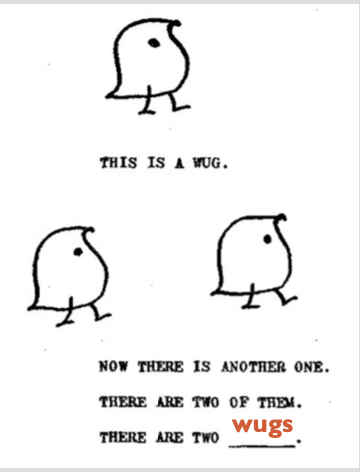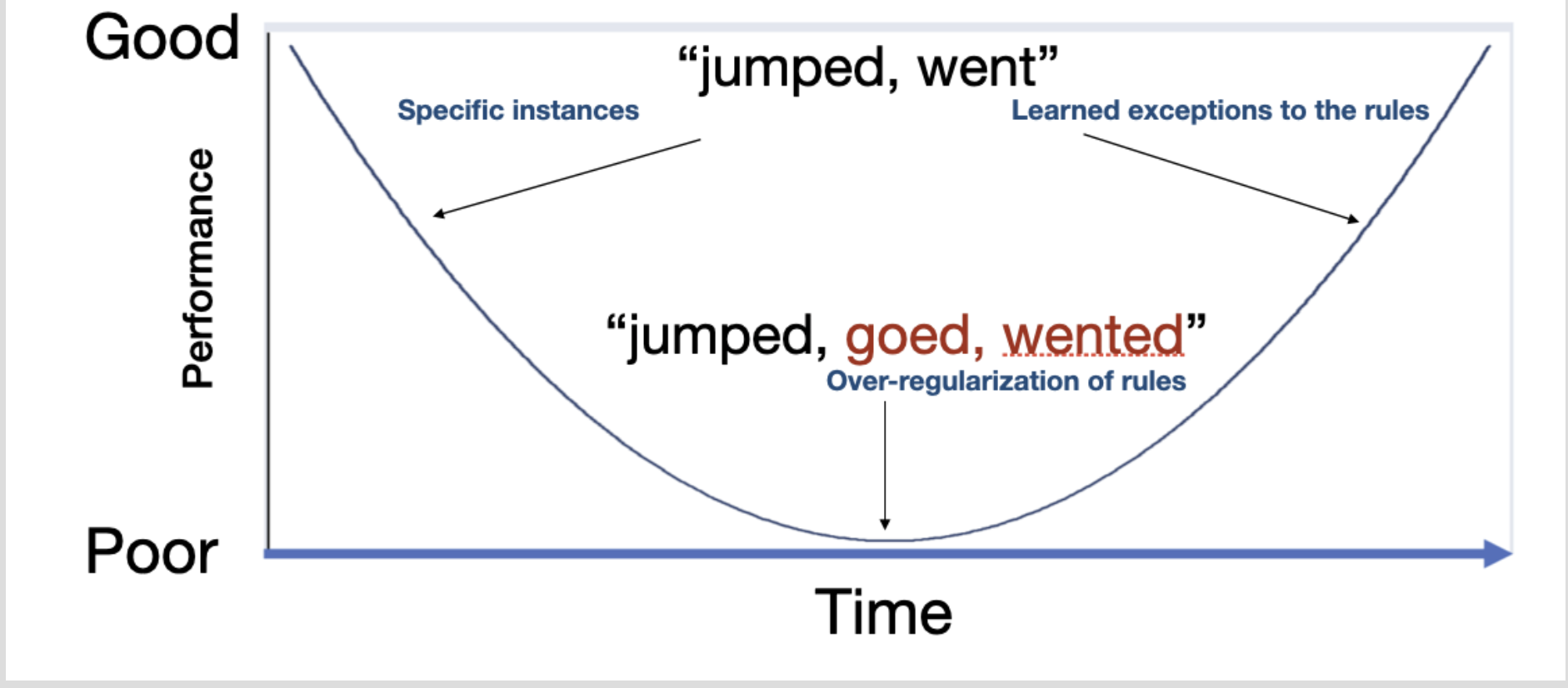PSYC 105: L8 Language
1/30
There's no tags or description
Looks like no tags are added yet.
Name | Mastery | Learn | Test | Matching | Spaced |
|---|
No study sessions yet.
31 Terms
Def Speech Sounds (Prosody) and give an example
The way a person speaks; learning about speech sounds, such as stress, rhythm, emphasis, and intonation, which begins before birth.
Ex. =
Pregnant women read a short story
aloud everyday for the last 6 weeks
of pregnancy.Newborns were played different stories
depending on their sucking rate.Newborns (2-3 days old) preferred
the story that they were exposed
to in the womb, even when the story
is told by someone other than their
mother.
Head Turn Preference Procedure
A procedure used to study phonological patterns in infants, involving habituating them to a stimulus and then introducing a violation to measure their interest.
7-month-olds showed more interest to the unfamiliar pattern, demonstrating the ability to extract abstract rules from limited input (phonological patterns)
What is challenging about word learning?
Referential Ambiguity (Gavagai Problem) = The problem of not knowing what a new word refers to when learning a language.
Name and define the 4 solutions to referential ambiguity.
Whole Object Assumption = The assumption that a new label refers to the whole object rather than its parts.
Mutual Exclusivity = The principle that a new word is likely a label for an object that doesn't already have a label.
Taxonomic Constraint = The idea that a new word refers to a basic category rather than a theme.
Syntactic Bootstrapping = Using syntactic structure to infer the meaning of a new word.
(all of these are privileged)
Morphology
The study of the composition of words (morphemes), which pre-school children (4-5 year olds) already demonstrate knowledge of.

Language Acquisition Device (LAD)
A hypothetical module of the human mind posited to account for children’s innate predisposition for language acquisition.
NOT a specific organ/brain region
Children are not born with specific sounds/words/rules of a particular language BUT they seem to be born with the idea of how languages can work
Parameter setting occurs during language learning
Analogous to an on/off switch
Critical Period Hypothesis
The process of lateralization develops rapidly between the ages of 2 and 5 years, then slows down, being complete by puberty. The brain is NOT lateralized at birth, but instead emerges gradually through maturation (aka critical period). Grammar can’t be acquired after this period.
Evidence:
• The linguistic abilities of young children can be recovered after brain damage
• The younger the child, the better the chances of a complete recovery
• The entire function of the left hemisphere can be taken over by the right if the child is young enough
Categorical Perception of sounds
Perceiving continuous variations in sound as belonging to distinct categories
Easier to distinguish between-category sounds than within-category.
Phoneme Restoration Effect
Thee effect of context on speech processing; Using semantic and syntactic context to “fill in the gaps” when a sound is missing, gap only noticeable if noises are replaced by silence.
Def. Lexicon and give two characteristics
A mental dictionary containing representations of words and all the information known about them.
lexical ambiguity can cause processing difficulties sometimes, but depends on sentence structure.
“Children’s stool good for use in garden” (multiple access) vs “I needed some money, so I went to the bank.” (selective access)
Selective Access
A model of lexical access in which only one meaning of a word is activated at a time.
Multiple Access
A model of lexical access in which all meanings of a word are activated simultaneously.
Parsing
Computing the syntactic structure of a sentence.
Knowing the syntactic category (e.g., N, V, Adj, Adv, etc.), how units combine to make bigger units (words to phrases, phrases to sentences)
Ambiguity exists on the syntactic level as well —> English speakers + “late closure” strategy —> Attach incoming words to current phrase, rather than creating a new one
Garden Path Sentence
Sentences that lead you to one interpretation, which turns out to be wrong, demonstrating how we process sentences incrementally.
“The horse raced past the barn fell”
Grammaticality Effect (regularities in speech errors)
Errors often occur within the same grammatical class (e.g., nouns for nouns; verbs for verbs).
Ex.:
I’m stuttering psycholinguistics. vs. I’m studying psycholinguistics
Consonant-Vowel Rule (regularities in speech errors)
Errors occur within the same phonological class (e.g., consonants for consonants; vowels for vowels).
rule of rum vs. rule of thumb
Lexical Bias Effect
Errors that make up real words are more likely than non-word errors.
Deep cot → Keep dot more likely than Deed Cop → Keed Dop
Tip-of-the-Tongue Phenomenon
Failure to retrieve a word, often coupled with partial recall and the feeling that successful retrieval is imminent..
Meaning and grammar can be accessed separately from pronunciation
Structural Priming
Exposure to one structure increases the likelihood of producing that structure again, even when the semantic content has changed.
Sentence frames can be planned independently of words.
Broca’s Aphasia
Halting speech, disordered syntax, and intact comprehension; damage to Broca's area is associated with this.
Wernicke’s Aphasia
Fluent speech, adequate syntax, and impaired comprehension; damage to Wernicke's area is associated with this.
Self-Monitoring
A mechanism that helps us detect and prevent errors before they are uttered.
Taboo errors are less common, demonstrating self-monitoring prior to articulation
Another example: ”hit shed”
Def “word spurt,” and when does it happen?
A short period of time where infants learn a whole new bunch of words
10-12 mo: first words
18 mo: 50 words
2.5 yr: 500 words
What is the time course for learning grammar?
Time course of learning irregular verb follows a “U-shaped development”

Imagine that we are making a minor change to the "wug" experiment, making it a "gutch" experiment. If children are able to say there are two "gutches" instead of "gutchs" or "gutch", what level of linguistic knowledge are they demonstrating?
a) Phonology
b) Morphonology
c) Syntax
d) Morphology and Syntax
e) Morphology and Phonology
e
What would B.F Skinner say about language learning?
Language is just like any other animal behavior, which can be shaped by different forms of conditioning (through repetition and reinforcement) (behaviorism)
Assuming that we start perceiving /p/ instead of /b/ at ~30 ms VOT, which of the following difference is the easiest to detect?
a. 40 vs. 60 ms VOT
b. 0 vs. 20 ms VOT
c. 20 vs. 40 ms VOT
d. They’re all about equally easy to detect.
c., because they belong to distinct categories.
Successive Lexical Decision Task
Say yes/no to whether the presented string is a word one after another
Conditions:
Appropriate: SAVE-BANK-MONEY
Inappropriate: RIVER-BANK-MONEY
Control: DAY-BANK-MONEY
Results: Appropriate < Control < Inappropriate, supporting selective access
Cross-Modal Priming
When the influence of one stimulus influences the stimulus of another in a different modality.
Participants listened to a passage and performed a lexical decision task.
Ex.:
passage abt bugs/spies
Lexical decision for ANT/SPY/SEW prompted after “bug” or “corner”
Facilitation for ANT and SPY after “bugs”
Facilitation for only ANT after “corner”
→ Support for multiple access
Describe the Speech Error Elicitation Procedure (SLIP)
Silently read the black words in your head, read the last words out loud
dead bug
dog bone
dust bell
doll bed
barn door ??
Describe picture-word interference
Name the picture while ignoring the superimposed word
The superimposed word is either phonologically related, semantically related, or not related to the target word
Naming times are measured
